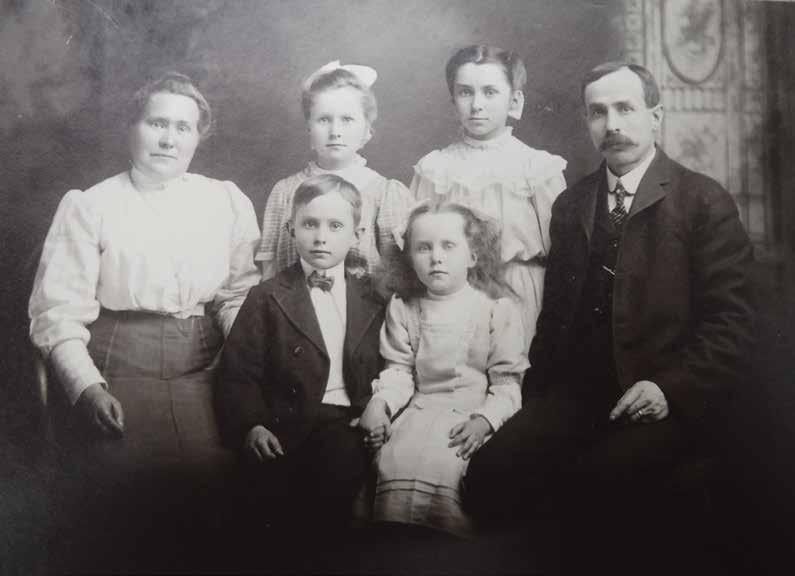
9 minute read
Carved in Marble Proctor’s Swedish Heritage Dorothy Dahm
CARVED IN MARBLE PROCTOR’S SWEDISH HERITAGE
Swedish Viking Society in 1911. Photo courtesy of the Proctor Historical Society
Advertisement
BY DOROTHY DAHM
Spring 2020 TODAY, PROCTOR IS A PEACEFUL HAMLET NESTLED IN VERMONT’S GREEN MOUNTAINS. But in the late nineteenth and early twentieth centuries, it was a bustling mining town. Immigrants from all over Europe worked in the town’s marble quarries. For a time, Swedes comprised the largest component of Proctor’s immigrant population.
Various documents identify Lars Larson as Proctor’s first Swedish resident. Legend has it that Larson met Senator Redfield Proctor, proprietor of the Vermont Marble Company, after landing in New York in the 1870s. Liking Larson’s looks, the Senator offered him a job in the marble quarries. In Proctor, then Sutherland Falls, Larson boarded with the Ormsbee family, who lived where the Proctor Free Library stands today.
According to one tale, Larson studied English in night school after toiling in the quarries all day. When some rowdy Irish youths threatened the teacher, the strapping Larson defended him. According to a Scandinavian magazine article, “The plan was frustrated due in large measure to the fearless attitude of the young giant.” The story had its basis in truth: Swedish workers often clashed with their Irish colleagues, who had hitherto been the largest immigrant group in town.
In the 1880s and 90s, Swedes poured into Proctor from a settlement in Mineville, New York and from the “old country” to work in the booming marble industry. They were quarry and mill workers, stone cutters and hand polishers, and, eventually, engineers, managers, and directors. Other Swedish immigrants were grocers, builders, farmers, and skilled tradesmen. In his Market Street factory, Gust Ljunquist made skis for the Scandinavian communities in Minnesota, Wisconsin, and Michigan.
Single women also immigrated to Proctor. They generally worked as domestic servants or at the Rutland hospital. Many were very young. According to one story, a twelve-yearold girl arrived in Vermont alone. Unable to speak English, she wore a tag on her cloak button with her name and destination.
Life was hard for the new arrivals. Often, five families occupied a single house. These were usually company houses owned by the Vermont Marble Company. Already overcrowded families took in boarders and did their tenants’ laundry to pay the debt they had incurred when they immigrated. These groups of houses all had Swedish names, many of which alluded to the residents’ living conditions. For example, Langholemen, a group of long houses, got its name from a Swedish military prison.
Herbert Johnson, Sr, writing in 1976, described his father’s experiences. Immigrating to Proctor in 1893, the elder Johnson worked seventy-two hours a week in the quarries. Take-home pay was “invariably traded at the company store.” To make ends meet, most families kept hens. Lucky families raised a pig or kept a cow.
Despite these hardships, the set-
above The Marble Valley Chapter of the Scandinavian Fraternity of America in the 1930s. Photo courtesy of the Proctor Historical Society. below Herbert and Anna Johnson in the early 1920s. Their daughter, Helen Newton, still lives in Proctor. Photo courtesy of Helen Newton.


tlers found joy. On Saturday nights in the 1880s and 90s, the young and single gathered in the woods near Pleasant Avenue. On a wooden platform, they performed Swedish folk dances to accordion music.
Because many settlers had the same last names, their fellow Swedes often gave them elaborate nicknames. A Mr. Johnson who lived in the woods was Johnson in the Woods. Pet Peterson, who kept a few cows, was Pet in the Barn, while a shoemaker was known as Swanson the Shoemaker.
As the Swedish community grew, so did its desire for a spiritual home. At first, traveling ministers preached in the town hall. Then, in 1889, the Swedish Free Church of Proctor, later called the Swedish Evangelical Mission, was built on Terrace Hill. The next year, Proctor’s Swedish Lutherans got their church. After laboring in the marble quarries, Lutheran men spent their evenings clearing a spot for the church on Gibbs Hill. Work was completed on St. Paul’s Evangelical Lutheran Church on Thanksgiving Day, 1890.
The two churches became the Swedish community’s center. Even in the early twentieth century, Swedes feared their children would lose their connection to Swedish culture. For several summers, the churches jointly held a morning summer school for six weeks. Children studied religion and some Swedish. The social event of the year was the Sunday school picnic, when Swedish families gathered on the West End of Eden Avenue. The churches retained close ties with their
sister churches, Salem Evangelical Lutheran Church in West Rutland and the Swedish Congregational Church in Center Rutland, as these communities also boasted large Swedish populations.
As years passed, the settlers prospered. In the early twentieth century, many built single-family homes, settling in and around Pleasant Street. This enclave was called the Garden of Eden because it felt like paradise after the company houses.
The Swedish community formed charitable and fraternal organizations. In the early twentieth century, the Scandinavian Fraternity of America, Swedish Viking Society, Swedish Order of Foresters, and the Swedish Aid Society had chapters in Proctor.
Many Swedes met their spouses in the Luther League, a social organization for young Lutherans. Writing in 1996, Alof Carlson recalled the League hiring a large sleigh, called a barge, which was pulled by two draft horses and held about 20 people. In 1921, 14-year-old Carlson attended a box social in West Rutland. For these events, young women prepared boxes of delicacies, which young men would bid on. Young Alof won a box prepared by a 20-year-old woman. “Imagine her dismay to share her box with a 14-year-old boy,” he wrote. Later, Carlson represented Proctor, Pittsford, and Sherburne in the Vermont State Legislature.
As time passed, the settlers’ descendants stopped speaking Swedish. By 1948, St. Paul’s Lutheran Church conducted all services in English. Still, some Swedish traditions persisted. Helen Newton, 97, and Carolyn Miglorie, 90, remember rising early on Christmas Day to
allen pond dental Healthy Smile. Healthy Heart.
An eco-friendly dental practice with an emphasis on your overall health. By maintaining a healthy mouth, your chance of illness is significantly reduced. Now that is something you and your family can smile about.
Allen Pond Dental is a preventive and restorative dental practice devoted to restoring your mouth to optimal comfort, function, and aesthetics using state-of-the-art procedures. Our goal is to treat patients who care about their health, retaining their natural teeth for as long as possible.

Joyce A. Hottenstein, D.M.D., invites you to learn how you can feel good about caring for your mouth while eco-friendly Allen Pond Dental cares for the environment.
Comprehensive Family Dentistry • Cosmetic Dentistry One Visit Metal-Free Restorations • TMD Jaw Pain • Whitening
Member of Eco-Dentistry Association that combines stewardship of client health with stewardship of planetary health.
above The Peterson family in 1905 or 1906. Back row: Anna Anderson Peterson, Agnes Christina Peterson, Ada Katarina Peterson, August Sigfrid Peterson. Front Row: Axel Sigfrid Peterson, Anna Victoria Peterson. Photo courtesy of the Proctor Historical Society. below John and Anna Dahlin immigrated to Proctor in 1915. John worked as a hand polisher for the Vermont Marble Company, and they raised nine children in the community. Photo courtesy of Kathie Cesarski.


42 attend Julotta, the early morning service. During Julotta, children sang in Swedish.
“We thought nothing of going to church at five in the morning,” Newton recalls with a chuckle.
Miglorie remembers walking to church in the snow. “Nothing kept us home,” she adds.
Both Newton and Miglorie enjoyed Swedish dishes during the holidays. Körv, a stuffed sausage, was good, but a lot of work. Miglorie’s mother and grandmother baked buns with cardamom, while Newton liked Ludfisk, a whitefish.
Younger members of Proctor’s Swedish community cherish their heritage. Debbie Dewey attends St.
I have learned that success is not so much the position you have reached, or even the obstacles you have overcome along the way. But rather the character you have maintained through it all ... No matter what you face in life - always take the high road - the view is so much better and the memories much sweeter!

-Judy Taranovich
Green Sustainable Energy
Propane Empowers

We have roots in the Rutland area, not just branches.
2 Market Street Proctor, Vermont 05765 (802) 459-3340 ProctorGas.com
• SEPTIC PUMPING • PORTABLE TOILETS • DRAIN CLEANING • NAWT CERTIFIED SEPTIC INSPECTORS
438-5722

• TV PIPE INSPECTION • PUMP STATION REPAIRS & INSTALLATION • GOULDS FACTORY TRAINED TECHNICIAN
RESIDENTIAL AND COMMERCIAL

JET VAC TRUCK SERVICES


WE SELL SEPTIC TANK RISERS!
Suzanne Jones, PA-C

Seth Coombs, M.D. Bruce Bullock, M.D.

Learn more at our WEBSITE YOUR HEALTH YOUR DOCTOR.com
Discover direct & comprehensive care for individuals who value a personal relationship with their doctor and the peace of mind that goes with it.

802-770-1807 8 Commons Street Rutland VT 05701
802-770-1805 8 Commons Street Rutland VT 05701
Moving to a senior community shouldn’t mean leaving your “best friend” behind.

Independent living opportunities now available.
Pet-Friendly • Dining • Housekeeping • Transportation • Maintenance • One & Two Bedroom Apartments • Health Services
44 For info or a tour, call Randi Cohn at 802-770-5275 or visit us online.
200 Gables Place, Rutland, VT www.thegablesvt.com
The original St. Paul’s Lutheran Church was built in 1890. The present structure dates from 1915. Photo of the old church courtesy of the Proctor Historical Society. Photo of the present church courtesy of St. Paul’s Lutheran Church.

Paul’s, where five generations of her family have worshipped. Still, she misses the older generation.
“My aunt, Mary Johnson, could identify everyone in the old photos and knew all the cooking techniques,” Dewey says. “We have the recipes for Swedish meatballs, buns, and cookies, but you need more than the right ingredients. You need to see how to chop the meat or knead the dough.”
Still, Proctor’s Swedish past lives on – in names engraved on marble, in St. Paul’s Church, and in the hearts of residents who remember Swedish treats, feasts, and words.
Rutland Magazine Dorothy A. Dahm's work has appeared in regional and national publications, including The Writer and Catster. She lives in Hubbardton, Vermont.
240 Stra on Road Rutland Vermont 05701
Generations Of Smiles


802-775-6981 New Patients Welcome
Dr. Sonia C.H. Yau www.cornerstonedentistryvt.com
When Was The Last Time You Felt Good About Buying Heating Oil? Propane, Heating and Motor Fuels, Heating and Cooling Equipment Sales and 24 hour service. Generac and Kohler Service
Keyser Energy donated $20,000 since April 2015 for our “Fueling A Cure”program to the VT/NH Komen Chapter.

A family and community minded company.









